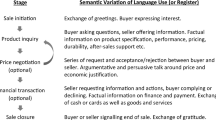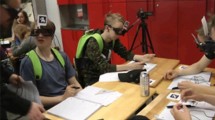Abstract
This study deals with the problem of how to collect genuine and useful data about science classroom practices, and preserving the complex and holistic nature of teaching and learning. Additionally, we were looking for an instrument that would allow comparability and verifiability for teaching and research purposes. Given the multimodality of teaching and learning processes, we developed the multimodal narrative (MN), which describes what happens during a task and incorporates data such as examples of students’ work, photos, diagrams, etc. Also, it describes teachers’ intentions, preserving the nature of teaching practice in natural settings and it is verifiable and comparable. In this paper, we show how the MN was developed and present the protocol that was used for its construction. We identify the main characteristics of the MN and place it in the context of international research. We explore the potential of the MN for research purposes, illustrating its use in a research study that we carried out. We find that the MN provides a way to gather, organize and transform data, avoiding confusing and time-consuming manipulation of data, while minimizing the natural subjectivity of the narrator. The same MN can be used by the same or by different researchers for different purposes. Furthermore, the same MN can be used with different analysis techniques. It is also possible to study research practices on a large scale using MNs from different teachers and lessons. We propose that MNs can also be useful for teachers’ professional development.



Similar content being viewed by others
References
Alsop, S., Bencze, L., & Pedretti, E. (Eds.). (2005). Analysing exemplary science teaching. Maidenhead: Open University Press.
Baldry, A., & Thibault, P. J. (2006). Multimodal transcription and text analysis. London: Equinox.
Bardin, L. (1997). L’analyse de contenu. Paris: PUF.
Borko, H., Stecher, B., & Kuffner, K. (2007). Using artifacts to characterize reform-oriented instruction: the scoop notebook and rating guide (CSE Technical Report 707). Los Angeles: The Regents of the University of California.
Bot, L., Gossiaux, P. B., Rauch, C. P., & Tabiou, S. (2005). Learning by doing: a teaching method for active learning in scientific graduate education. European Journal of Engineering Education, 30(1), 105–119.
Branco, M. J., Magalhães, R., Ferreira, A., Lopes, J., & Cravino, J. (2009). Narrações de aulas: um estímulo ao desenvolvimento profissional? In F. Paixão & F. Jorge (Eds.), Proceedings XIII Encontro Nacional de Educação em Ciências (pp. 740–749). Castelo Branco: Instituto Politécnico de Castelo Branco.
Bruner, J. (1986). Actual minds, possible worlds. Cambridge, MA: Harvard University Press.
Chang, W., & Bell, B. (2002). Making content easier or adding more challenge in year one university physics? Research in Science Education, 32(1), 81–96.
Clandinin, D. J., & Connelly, F. M. (2000). Narrative inquiry: experience and story in qualitative research. San Francisco, CA: Jossey-Bass.
Clemente, M., & Ramírez, E. (2008). How teachers express their knowledge through narrative. Teaching and Teacher Education, 24(5), 1244–1258.
Cohen, L., Manion, L., & Morrison, K. (2010). Research methods in education (6th ed.). London: Routledge.
Craig, C. J. (2011). Narrative inquiry in teaching and teacher education. In K. Julian, P. Darlene Ciuffetelli, & P. Debbie (Eds.), Advances in research on teaching (vol. 13) (pp. 19–42). Bingley: Emerald Group.
Cunha, A. E., et al. (2012). The influence of the teacher’s research experience in his mediation of secondary school students learning using computer simulations. In R. Pintó, V. López, & C. Simarro (Eds.), Learning Science in the Society of Computers (pp. 11–19). Barcelona: Centre for Research in Science and Mathematics Education (CRECIM).
Damasio, A. (2010). Self comes to mind: constructing the conscious brain (1st ed.). USA: Pantheon.
Engeström, Y. (2001). Expansive learning at work: toward an activity theoretical reconceptualization. Journal of Education and Work, 14(1), 133–156.
Felder, R. M., Woods, D. R., Stice, J. E., & Rugarcia, A. (2000). The future of engineering education II. Teaching methods that work. Chemical Engineering Education, 34(1), 26–39.
Georgakopoulou, A. (2006). Thinking big with small stories in narrative and identity analysis. Narrative Inquiry, 16(1), 122–130.
Hage, S. E., & Buty, C. (2012). The effect of an ICT on the coherence of the teacher discourse: case study of an electricity sequence at grade 12. In R. Pintó, V. López, & C. Simarro (Eds.), Learning science in the society of computers (pp 41–47). Barcelona: Centre for Research in Science and Mathematics Education (CRECIM).
Hammersley, M. (2010). Reproducing or constructing? Some questions about transcription in social research. Qualitative Research, 10(5), 553–569.
Hill, A. M., & Smith, H. A. (2005). Problem-based contextualized learning. In S. Alsop, L. Bencze, & E. Pedretti (Eds.), Analysing exemplary science teaching. Berkshire: Open University Press.
Hundhausen, C. D. (2002). Integrating algorithm visualization technology into an undergraduate algorithms course: ethnographic studies of a social constructivist approach. Computers & Education, 39(3), 237–260.
Kelly, G. J., Brown, C., & Crawford, T. (2000). Experiments, contingencies and curriculum: providing opportunities for learning through improvisation in science teaching. Science Education, 84(5), 624–657.
Kramp, M. K. (2004). Exploring life and experience through narrative inquiry. In M. Kathleen De & S. D. Lapan (Eds.), Foundations for research: methods of inquiry in education and the social sciences. New Jersey: Erlbaum.
Kung, R. L., Kung, P., & Linder, C. (2005). Equipment issues regarding the collection of video data for research. Physical Review Special Topics-Physics Education Research 1(1), 010105-1/010105-9.
Labov, W. (2006). Narrative pre-construction. Narrative Inquiry, 16(1), 37–45.
Lemke, J. L. (2005). Research for the future of science education: multiple sites, media and goals. Invited paper presented at the VII Congreso Internacional sobre Investigación en la Didáctica de las Ciencias. Spain: Granada.
Lopes, J. B., Cravino, J. P., Branco, M., Saraiva, E., & Silva, A. A. (2008a). Mediation of student learning: dimensions and evidences in science teaching. PEC 2008—problems of education in the 21st century, 9, 42–52.
Lopes, J. B., Silva, A. A., Cravino, J. P., Costa, N., Marques, L., & Campos, C. (2008b). Transversal traits in science education research relevant for teaching and research: a meta-interpretative study. Journal of Research in Science Teaching, 45(5), 574–599.
Lopes, J. B., Cravino, J. P., & Silva, A. A. (2010a). A model for effective teaching in science and technology (METILOST). New York: Nova Science.
Lopes, J. B., Silva, A. A., Cravino, J. P., Viegas, C., Cunha, A. E., Saraiva, E., et al. (2010b). Investigação sobre a Mediação de professores de Ciências Físicas em sala de aula. Vila Real: Universidade de Trás-os-Montes e Alto Douro.
Lopes, J. B., Viegas, C., & Cravino, J. P. (2010c). Improving the learning of physics and the development of competences in engineering students. International Journal of Engineering Education, 26(3), 612–627.
Lopes, J. B., Branco, M., & Jiménez-Aleixandre. (2011). ‘Learning experience’ provided by science teaching practice in a classroom and the development of students’ competences. Research in Science Education, 41(5), 787–809.
Magnani, L. (2004). Reasoning through doing. Epistemic mediators in scientific discovery. Journal of Applied Logic, 2(4), 439–450.
Martin, A. M., & Hand, B. (2009). Factors affecting the implementation of argument in the elementary science classroom. A longitudinal case study. Research in Science Education, 39(1), 17–38.
Martínez, J. F., Borko, H., & Stecher, B. M. (2012). Measuring instructional practice in science using classroom artifacts: lessons learned from two validation studies. Journal of Research in Science Teaching, 49(1), 38–67.
Mason, J. (2002). Researching your own practice: the discipline of noticing. New York: Routledge.
Melville, W. (2008). Mandated curriculum change and a science department: a superficial language convergence? Teaching and Teacher Education, 24(5), 1185–1199.
Mugur-Schächter, M. (2002). Objectivity and descriptional relativities. Foundations of Science, 7(1–2), 73–180.
Murtonen, M., & Lehtinen, E. (2003). Difficulties experienced by education and sociology students in quantitative methods courses. Studies in Higher Education, 28(2), 171–185.
Perelman, C., & Olbrechts-Tyteca, L. (2000). Traité de l’argumentation. Bruxelles: Editions de l’Université de Bruxelles.
Pinto, A., Barbot, A., Viegas, C., Silva, A. A., Santos, C. A., & Lopes, J. B. (2012). Teacher education using computer simulations—pre and in-service primary school teacher training to teach science. In R. Pintó, V. López, & C. Simarro (Eds.), Learning science in the society of computers (pp. 28–36). Barcelona: Centre for Research in Science and Mathematics Education (CRECIM).
Reiser, B. J. (2004). Scaffolding complex learning: the mechanisms of structuring and problematizing student work. Journal of the Learning Sciences, 13(3), 273–304.
Reveles, J., Cordova, R., & Kelly, G. (2004). Science literacy and academic identity formulation. Journal of Research in Science Teaching, 41(10), 1111–1144.
Reveles, J., Kelly, G., & Durán, R. (2007). A sociocultural perspective on mediated activity in third grade science. Cultural Studies of Science Education, 1(3), 467–495.
Richter, T., & Schmid, S. (2010). Epistemological beliefs and epistemic strategies in self-regulated learning. Metacognition and Learning, 5(1), 47–65.
Ricoeur, P. (1988). Time and narrative. Chicago: University of Chicago Press.
Rowan, B., Camburn, E., & Correnti, R. (2004). Using teacher logs to measure the enacted curriculum: a study of literacy teaching in third–grade classrooms. The Elementary School Journal, 105(1), 75–101.
Santos, C. A., Lopes, J. B., & Cravino, J. P. (2011). Patterns of didactic decisions made by teachers in physical sciences classrooms. Problems of Education in the 21st Century, 36, 76–89.
Saraiva, E., Lopes, J. B., Cravino, J. P., & Santos, C. A. (2012). How do teachers of physical sciences with different professional experiences use visual representations with epistemic functions in the classroom. Problems of Education in the 21st Century, 42, 97–114.
Scott, R. H., & Fisher, D. L. (2004). Development, validation and application of a Malay translation of an elementary version of the questionnaire on teacher interaction. Research in Science Education, 34(2), 173–194.
Stein, S. J., Isaacs, G., & Andrews, T. (2004). Incorporating authentic learning experiences within a university course. Studies in Higher Education, 29(2), 239–258.
Stinner, A. (1995). Contextual settings, science stories, and large context problems: toward a more humanistic science education. Science Education, 79(5), 555–581.
Tan, A. L., & Towndrow, P. A. (2009). Catalyzing student–teacher interactions and teacher learning in science practical formative assessment using digital video technology. Teaching and Teacher Education, 25(1), 61–67.
Tytler, R. (2003). A window for a purpose: developing a framework for describing effective science teaching and learning. Research in Science Education, 33(3), 273–298.
Vygotsky, L. S. (1962). Thought and language. Cambridge, MA: MIT Press.
Winkler, G. (2001). Reflection and theory: conceptualising the gap between teaching experience and teacher expertise. Educational Action Research, 9(3), 437–449.
Yuruk, N., Beeth, M. E., & Andersen, C. (2009). Analyzing the effect of metaconceptual teaching practices on students’ understanding of force and motion concepts. Research in Science Education, 39(4), 449–475.
Acknowledgments
This work is funded (or part-funded) by the European Regional Development Fund (ERDF) through the COMPETE Programme (operational programme for competitiveness) and by National Funds through the Fundação para a Ciência e a Tecnologia (FCT; Portuguese Foundation for Science and Technology) within the project “The role of teacher mediation using Computer simulations to improve students’ learning of physical and engineering sciences./PTDC/CPE/112303/2009”. We acknowledge the support of FCT (Fundação para a Ciência e Tecnologia—Portuguese Foundation for Science and Technology) through scholarships SFRH/BD/36780/2007 and SFRH/BD/28508/2006.
Author information
Authors and Affiliations
Corresponding author
Rights and permissions
About this article
Cite this article
Lopes, J.B., Silva, A.A., Cravino, J.P. et al. Constructing and Using Multimodal Narratives to Research in Science Education: Contributions Based on Practical Classroom. Res Sci Educ 44, 415–438 (2014). https://doi.org/10.1007/s11165-013-9381-y
Published:
Issue Date:
DOI: https://doi.org/10.1007/s11165-013-9381-y




